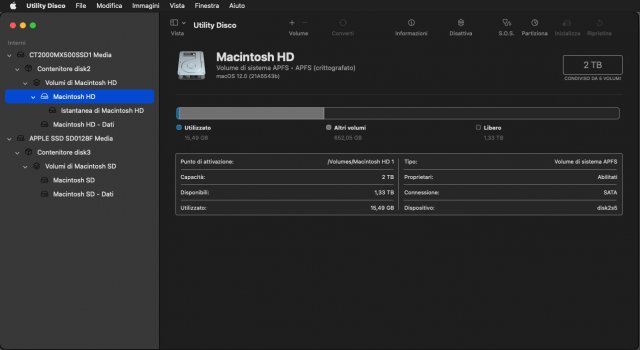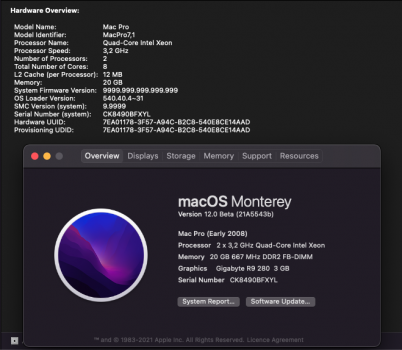HELP ME KINDLY, PLEASE!
After updating to Monterey Beta 9 the nVIDIA graphics acceleration no longer works and as you can see, from the LOG below with in Bold text, "OCLP Post Install Patch" detects conflicts and seems to have problems ...
I tried from OCLP 0.2.5 to OCLP a while ago the KEXTs are no longer copied to /System/Library/Extensions/ as happened with Beta 7.
So! In /System/Library/Extensions/ I don't see the nVidia KEXTs that the Patch should add.
I did a lot of tests, both by installing Beta 9 from the Application created with Install Assistant and by installing from USB-Key, always with OCLP 0.3.0
What am I doing wrong? I have used both OCLP TUI and GUI
Thanks
EDIT
I just found that the Monterey's Disk Utility now displays the system disk (Macintosh HD) in a different way. I don't know if because Apple has changedmodality or if it's a my issue.
Until now Monterey Disk Utility saw a long code as name of a Virtual disk (snapshot), but now Monterey sees its internal disk (Macintosh HD) differently, without a long Code name.
I attach a clip
I add also diskutil APFS list
After updating to Monterey Beta 9 the nVIDIA graphics acceleration no longer works and as you can see, from the LOG below with in Bold text, "OCLP Post Install Patch" detects conflicts and seems to have problems ...
I tried from OCLP 0.2.5 to OCLP a while ago the KEXTs are no longer copied to /System/Library/Extensions/ as happened with Beta 7.
So! In /System/Library/Extensions/ I don't see the nVidia KEXTs that the Patch should add.
I did a lot of tests, both by installing Beta 9 from the Application created with Install Assistant and by installing from USB-Key, always with OCLP 0.3.0
What am I doing wrong? I have used both OCLP TUI and GUI
Thanks
EDIT
I just found that the Monterey's Disk Utility now displays the system disk (Macintosh HD) in a different way. I don't know if because Apple has changedmodality or if it's a my issue.
Until now Monterey Disk Utility saw a long code as name of a Virtual disk (snapshot), but now Monterey sees its internal disk (Macintosh HD) differently, without a long Code name.
I attach a clip
Code:
The following patches will be applied:
- Add Legacy Nvidia Kepler Graphics Patch
Would you like to continue with Root Volume Patching?(y/n): y
- Continuing with Patching
- Verifying whether Root Patching possible
- Patcher is capable of patching
- Apple binaries missing
- Found local 12-Monterey zip, skipping download
- Duplicating into Apple.zip
- Download completed
- Unzipping download...
- Renaming folder
- Binaries downloaded to:
/private/var/folders/tj/399vw2z94z3f37q51l2g3w300000gn/T/_MEI9U47pf/payloads
Press [ENTER] to continue
- Found Root Volume at: disk2s5
- Root Volume is already mounted
- Running patches for iMac14,2
- Installing Kepler Patches
- Detected supported OS, installing Acceleration Patches
- Installing Kepler Acceleration Kext patches for Monterey
- Found conflicting kext, Deleting Root Volume's GeForce.kext
Password:
- Adding GeForce.kext
- Found conflicting kext, Deleting Root Volume's GeForceAIRPlugin.bundle
- Adding GeForceAIRPlugin.bundle
- Found conflicting kext, Deleting Root Volume's GeForceGLDriver.bundle
- Adding GeForceGLDriver.bundle
- Found conflicting kext, Deleting Root Volume's GeForceMTLDriver.bundle
- Adding GeForceMTLDriver.bundle
- Found conflicting kext, Deleting Root Volume's GeForceVADriver.bundle
- Adding GeForceVADriver.bundle
- Found conflicting kext, Deleting Root Volume's NVDAGF100Hal.kext
- Adding NVDAGF100Hal.kext
- Found conflicting kext, Deleting Root Volume's NVDAGK100Hal.kext
- Adding NVDAGK100Hal.kext
- Found conflicting kext, Deleting Root Volume's NVDAResman.kext
- Adding NVDAResman.kext
- Found conflicting kext, Deleting Root Volume's NVDAStartup.kext
- Adding NVDAStartup.kext
Press [ENTER] to continue with cache rebuild:
- Rebuilding Kernel Cache (This may take some time)
- Successfully built new kernel cache
Press [ENTER] to continue with snapshotting
- Creating new APFS snapshot
Can't use last-sealed-snapshot or create-snapshot on non system volume
- Unmounting Root Volume (Don't worry if this fails)
disk2s5 was already unmounted
- Patching complete
Please reboot the machine for patches to take effect
Press [ENTER] to continueI add also diskutil APFS list
Code:
Vincenzo@iMac-Studio ~ % diskutil APFS list
APFS Containers (2 found)
|
+-- Container disk2 32444E9C-A6B7-4E8C-82FD-95770C79F07A
| ====================================================
| APFS Container Reference: disk2
| Size (Capacity Ceiling): 2000189177856 B (2.0 TB)
| Capacity In Use By Volumes: 667856519168 B (667.9 GB) (33.4% used)
| Capacity Not Allocated: 1332332658688 B (1.3 TB) (66.6% free)
| |
| +-< Physical Store disk0s2 9E30BB16-B827-42D4-8408-D3B59E241C2D
| | -----------------------------------------------------------
| | APFS Physical Store Disk: disk0s2
| | Size: 2000189177856 B (2.0 TB)
| |
| +-> Volume disk2s1 C0D6933E-2E9F-49A4-AAE2-FE2BDEEC8134
| | ---------------------------------------------------
| | APFS Volume Disk (Role): disk2s1 (Data)
| | Name: Macintosh HD - Dati (Case-insensitive)
| | Mount Point: /System/Volumes/Data
| | Capacity Consumed: 648963731456 B (649.0 GB)
| | Sealed: No
| | FileVault: Yes (Unlocked)
| |
| +-> Volume disk2s2 0F3C085F-C0E8-49D1-94F4-BE1DC7418152
| | ---------------------------------------------------
| | APFS Volume Disk (Role): disk2s2 (Preboot)
| | Name: Preboot (Case-insensitive)
| | Mount Point: /System/Volumes/Preboot
| | Capacity Consumed: 497557504 B (497.6 MB)
| | Sealed: No
| | FileVault: No
| |
| +-> Volume disk2s3 DB6EBBDD-A947-44AE-A265-9EF14336E28D
| | ---------------------------------------------------
| | APFS Volume Disk (Role): disk2s3 (Recovery)
| | Name: Recovery (Case-insensitive)
| | Mount Point: Not Mounted
| | Capacity Consumed: 1094299648 B (1.1 GB)
| | Sealed: No
| | FileVault: No
| |
| +-> Volume disk2s4 21A5D6D3-3259-435F-8DA0-B3E4C90C2963
| | ---------------------------------------------------
| | APFS Volume Disk (Role): disk2s4 (VM)
| | Name: VM (Case-insensitive)
| | Mount Point: /System/Volumes/VM
| | Capacity Consumed: 1069056 B (1.1 MB)
| | Sealed: No
| | FileVault: No
| |
| +-> Volume disk2s5 9018CC30-82C3-4491-B0E2-C45F3CA0E003
| ---------------------------------------------------
| APFS Volume Disk (Role): disk2s5 (System)
| Name: Macintosh HD (Case-insensitive)
| Mount Point: /Volumes/Macintosh HD 1
| Capacity Consumed: 15490473984 B (15.5 GB)
| Sealed: Broken
| FileVault: Yes (Unlocked)
| Encrypted: No
| |
| Snapshot: C4EE6397-3BAC-4535-83DA-E63238E54166
| Snapshot Disk: disk2s5s1
| Snapshot Mount Point: /
| Snapshot Sealed: Yes
|Attachments
Last edited:



